Vol 2 No. 19 TROPIC LIGHTNING NEWS May 15, 1967
Index
Fire Fights Route Enemy
Elements of the 25th Inf. Div. on operation "Manhattan" killed
three Viet Cong and detained eight others while searching the heavily vegetated
Boi Loi and Ho Bo Woods, 56 kms north of Saigon.
Units from the "Tropic Lightning" Division's 1st Bn. (Mech),
5th Inf., killed three guerrillas and detained seven prisoners in the northern
edge of the Ho Bo Woods during a brief but violent fire fight with an enemy
force of unknown size.
COL M.D. Fuller, 2nd Bde. commander, was in his command helicopter
over the area when he spotted several VC running across an open field. As
the guerrillas reached the woodline, COL Fuller noticed the movements of a
larger group. Circling overhead, he directed artillery fire into the woods
and called in helicopter gunships to seal the area off.
Meanwhile, he directed elements of the mechanized infantry to close
with the guerrillas. One Viet Cong was killed after he fired on an armored
personnel carrier with an RPG-2 rocket launcher. Five others were spotted
entering a tunnel and were taken alive. Two more VC were detained and one
additional guerrilla was killed while trying to escape from the aggressive
infantrymen. One prisoner was also detained by the 3rd Bde., 4th Inf.
Div., operating with the 25th Division.
Tropic Lightning infantrymen also captured four small arms, a
rocket launcher and rocket, five pounds of medical supplies, 17 tons of rice,
3000 cans of milk, and 15 pounds of documents.
| During the first nine days of Operation
"Manhattan" more ammo has been found by the 25th Inf. Div. than in all of
1966, according to LTC Guy W. Troy, assistant chief of staff, intelligence
(G-2). Locations of numerous caches found during this period are indicated numerically. The map does not include the entire "Manhattan" operational area. Locations are approximate and numbers do not include all caches. |
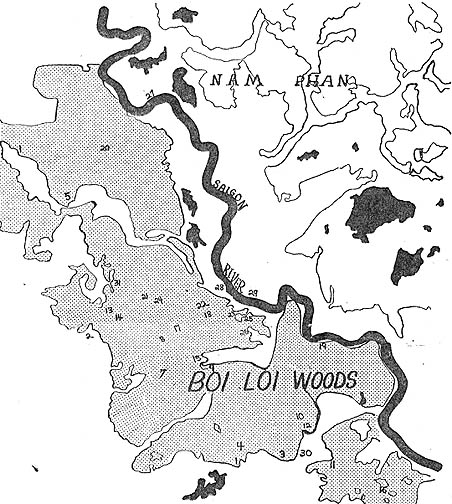 |
Found were: (1) four underground fortifications (UFs), seven CHICOM claymores and 20 carbines; (2) 30 UFs, 50 foxholes, 12 M-79 rounds and three CHICOM claymores; (3) 21 French rifles; (4) four CHICOM claymores, 17 lbs TNT and 30 claymore castings; (5) three tons of rice; (6) 152 lbs medical supplies and 50 lbs clothing; (7) 23 UFs; (8) 43 booby traps, 384 81mm and 82mm mortar rounds, 100 60mm mortar rds, 105,836 rounds small arms ammo, 2100 lbs demolitions, 800 feet primer cord, 1500 lbs cement, 3200 blasting caps, 71 CHICOM carbines, 119 Mauser rifles, 29 Soviet light machineguns and numerous other weapons; (9) 208 lbs clothing; (10) 90,000 lbs rice and 600 lbs fish; (11) VC base camp; (12) 600 lbs fish, 150 sheets of tin and 45 tons rice; (13) 41 UFs; (14) 40 UFs; (15) 200 lbs TNT, 1500 lbs cement, 300 lbs lime, 130,000 rounds small arms ammo and 500 4.24 batteries; (16) 14 tons rice; (17) 12 claymore mines, 500 feet detonating cord, 3000 blasting caps, 84 AP mines, seven 75mm recoilless rifle rds, 60 80mm mortar rounds, 324 82mm mortar rounds, 1600 lbs TNT, 10 booby traps and 57,836 rounds small arms ammo; (18) 7500 lbs rice; (19) 46 UFs; (20) five tons rice; (21) VC commo center with misc. radio equipment; (22) 35 tons rice; (23) 50 tons rice; (24) 16 UFs; (25) 3000 cans milk and 12 tons rice; (26) numerous sampans; (27) 900 cans milk, 40 lbs clothing, 200 lbs medical supplies and 35 blankets; (28) numerous tunnel complexes. |
ARVNs - VC Quick
ARVNs Find Hospital
The 34th ARVN Ranger Bn. has uncovered a Viet Cong hospital and
base camp area deep in the Boi Loi Woods.
The Vietnamese unit is conducting search and destroy operations
in conjunction with the 2nd Bde. of the 25th Inf. Div. in the dense jungle area.
The hospital, complete with over 200 pounds of medical supplies,
was discovered by the unit as they methodically searched the heavily wooded Viet
Cong stronghold. The medical supplies, 40 military uniforms, 25 blankets,
and several small arms were either evacuated or destroyed by the soldiers of the
unit.
Cong Can Move Fast
The men of Co. C, 1st Bn. (Mech), 5th Inf. recently discovered just
how fast the Viet Cong can change a safely cleared area into a deadly trap.
"Charlie" had made his point with three "stick mines." Another element of the 25th Div. unit had led the way
without incident through a large open area. Moments later, as the armored
personnel carriers (APCs) of Co. C rumbled down the trail made by the first
unit, the lead vehicles slammed to a stop.
The Viet Cong had neatly planted three "stick mines" right in
the track prints the drivers were following. The stick mine is a large
anti-tank mine triggered when a vehicle rolls over an upright metal or bamboo
stick.
The mines were safely blown in place.
Chopper Hit
"If anyone had been sitting in the left seat, it would have been
all over," said WO Walter Cooke, describing his run-in with Viet Cong ground
fire over the Boi Loi Woods during Operation "Manhattan."
Cooke, a pilot for the 25th Inf. Div.'s 2nd Bde. Aviation Section
had just lifted his tiny observation helicopter above the dense jungle when he
heard the cracking of automatic weapons fire around him.
"Just as I began to swerve the ship to escape the fire, three
rounds hit," said Cooke. Two rounds went through the open door next to
his head and crashed through the aircraft's plastic bubble. A third
round ripped through the left passenger seat and up through the bubble.
Cooke had dropped off two passengers just moments before and was on
his way to another mission.
"The whole thing didn't bother me until I realized just how
close those rounds came to my helmet," said Cooke.
He has been in Vietnam for less than a month.
3rd Bde. Kills 45 VC in Operation 'Oregon'
DUC PHO - In the first seven hours of Task Force "Oregon," the
3rd Bde. Task Force, 25th Inf. Div. killed 45 Viet Cong in a battle on the coast
near here.
Thirty VC were killed by 1st Bn., 35th Inf., "Cacti Green"
automatic weapons fire, and 15 more by artillery fire thrown into the area.
Five U.S. soldiers were injured, none seriously.
The "Bronco" Brigade, after completing Operation "Pershing"
south of Bong Son and after participating in the final two days of Operation "Lejeune,"
closed in on the Duc Pho area by air and sea April 19 to begin Oregon.
The brigade's sea assault was the first of Task Force Oregon.
It initiated one of the rare sea resupply routes (Qui Nhon to Duc Pho)
established by the Army during the Vietnam War.
Earlier, on April 16, the 2nd Bn., 35th Inf. was the first element
of the 25th Div. to battle VC in Duc Pho District, killing 43 and suffering only
one slightly wounded U.S. casualty.
District intelligence sources estimate the population around Duc
Pho District to be 75 per cent Communist, an indication that Duc Pho should occupy
U.S. forces for quite awhile.
Oregon is being conducted near Duc Pho in I Corps area.
MG William B. Rosson is commanding general of the Task Force.
Page 2 TROPIC LIGHTNING NEWS May 15, 1967
Decorated
| SILVER STAR | |
|
LTC George S. Webb., Jr., HHT, 3rd Sqdn., 4th Cav. SP4 Clarence F. Gipson, Co. A, 4th Bn., 9th Inf. |
SP4 Garland A. Newhouse, Btry. B, 2nd Bn., 77th Arty. |
| BRONZE STAR (VALOR) |
|
|
MAJ John W. Loffert, HHC, 2nd Bn., 27th Inf SGT Gary Brooks, Co. A, 4th Bn., 9th Inf. SP4 David D. Berkholz, Co. A, 2nd Bn. (Mech), 22nd Inf. SP4 James R.. Hintz, Co. B, 3rd Bn., 22nd Inf. |
SP4 David C. Rogers, Btry. C, 2nd Bn., 77th Arty. SP4 Algernon P. Thomas, Btry. B, 2nd Bn., 77th Arty PFC Thomas L. Bell, HHC, 3rd Bn., 22nd Inf. PFC Jack R. Trim, Co. A, 4th Bn., 9th Inf. |
| AIR MEDAL (VALOR) |
|
|
MAJ Michael J. Kubas, HHC, 1st Bde., 25th Inf. Div. CPT Walter B. Stewart, Co. A, 25th Avn. Bn. CPT Robert F. Winters, HHB, 7th Bn., 11th Arty. 1LT Frank S. Owen Jr., Co. B, 25th Avn. Bn. WO1 James P. Barry, Co. A, 25th Avn. Bn. WO1 Jon C. Jensen, Co. A, 25th Avn. Bn. WO1 Heriberto Vasquez, Co. B, 25th Avn. Bn. SP4 Chester G. Atkins, Co. B, 25th Avn. Bn. SP4 Andrew E. Carr, Co. A, 25th Avn. Bn. |
SP4 Robert E. Masterson, Co. A, 25th Avn. Bn. SP4 Leo B. Miller, Trp. D, 3rd Sqdn., 4th Cav. SP4 Gene E. Nix, Co. A, 25th Avn. Bn. PFC Gerald D. Arnold, Co. A, 25th Avn. Bn. PFC John B. Decausmaker, Co. A, 25th Avn. Bn. PFC Paul D. Eaves, Co. A, 25th Avn. Bn. PFC Johnny L. Edwards, Co. A, 25th Avn. Bn. PFC Joseph C. Fazio, Co. A, 25th Avn. Bn. PFC John E. Gannon, Co. A, 25th Avn. Bn. |
| BRONZE STAR |
|
|
LTC James B. Colson, HHC & Band LTC Edward P. Davis, HHD, 25th Avn. Bn. CPT John C. Cartland Jr., HHB, 2nd Bn., 77th Arty. CPT Herbert Kuhl, HHC, 4th Bn. (Mech), 23rd Inf. CPT William W. Little, HHC, 4th Bn. (Mech), 23rd Inf. CPT Michael J. Lombardo, H&S Btry., 7th Bn., 11th Arty. CPT Benjamin J. McPherson, 25th Admin. Co. 1LT Charles Dickey, Co. B, 1st Bn. (Mech), 5th Inf. 1LT Ronald L. Johnson, HHC, 2nd Bn., 14th Inf. 1LT Gary L. Meyer, HHB, 25th Div. Arty. SFC Nelson K. Hayashi, 25th Admin. Co. SSG James E. Bostock, Co. A, 1st Bn. (Mech), 5th Inf. SSG Benjamin F. Kelly Jr., HHT, 3rd Sgdn., 4th Cav. SSG James K. Lindsey, Co. A, 1st Bn. (Mech), 5th Inf. SSG William T. Webb, 25th Admin. Co. SGT Walter R. Blalock, A Trp., 3rd Sqdn., 4th Cav. SGT Loyd L. McBroom, Co. C, 4th Eng. SGT Larry R. Scott, Co. A, 65th Engr. Bn. |
LTC James B. Colson, HHC & Band LTC Edward P. Davis, HHD, 25th Avn. Bn. CPT John C. Cartland Jr., HHB, 2nd Bn., 77th Arty. CPT Herbert Kuhl, HHC, 4th Bn. (Mech), 23rd Inf. CPT William W. Little, HHC, 4th Bn. (Mech), 23rd Inf. CPT Michael J. Lombardo, H&S Btry., 7th Bn., 11th Arty. CPT Benjamin J. McPherson, 25th Admin. Co. 1LT Charles Dickey, Co. B, 1st Bn. (Mech), 5th Inf. 1LT Ronald L. Johnson, HHC, 2nd Bn., 14th Inf. 1LT Gary L. Meyer, HHB, 25th Div. Arty. SFC Nelson K. Hayashi, 25th Admin. Co. SSG James E. Bostock, Co. A, 1st Bn. (Mech), 5th Inf. SSG Benjamin F. Kelly Jr., HHT, 3rd Sgdn., 4th Cav. SSG James K. Lindsey, Co. A, 1st Bn. (Mech), 5th Inf. SSG William T. Webb, 25th Admin. Co. SGT Walter R. Blalock, A Trp., 3rd Sqdn., 4th Cav. SGT Loyd L. McBroom, Co. C, 4th Eng. SGT Larry R. Scott, Co. A, 65th Engr. Bn. |
|
PURPLE HEART |
|
|
CPT Wilfried H. Kast, Co. B, 25th Avn. Bn. 1LT Gerald R. Abbott, Co. C, 1st Bn. (Mech), 5th Inf. |
SFC Miguel A. Perez, HHC, 2nd Bn., 14th Inf. SSG Walter L. Boardwell, HHC, 4th Bn., 9th Inf. |
Editorial
Pay Bill Moves Through Congress
Legislation now before Congress proposes a 5.6 per cent basic pay
increase for members of the Armed Forces.
In this pay bill, the Department of Defense sent a request
simultaneously to the Speaker of the House and the President of the Senate as
part of the Defense legislative program.
The measure has been referred by both houses to their Armed
Services Committees. The chairman of each committee has introduced an
identical bill on the proposal. In a bill of this nature, hearings are
normally held and Defense Department officials asked to testify.
Once in a committee, the bill may be amended. Assuming a
favorable report is made by the committee, the bill is then sent to the floor of
the House or Senate to be debated. At the end of the debate, a voice or
roll-call vote is taken and if the bill passes by a majority, it is sent to the
Senate (assuming the House acted first) where the House bill is considered.
If the Senate has not yet held hearings on its bill, it will consider the House
proposal, but may amend it and report out a new bill.
If the House and Senate debate their own bills and pass them with
any differences between the two or if an amended version of the House bill is
passed by the Senate, a conference committee is appointed by each House to
resolve the differences.
Once approved by both House and Senate, the bill is sent to the
President. The bill becomes law after it is signed by the President or
when passed a second time by a two-thirds vote of Congress over a Presidential
veto.
If the President holds the bill 10 calendar days (excepting Sunday)
without signing it, the bill automatically becomes law. However, if
Congress adjourns during the 10 days, the bill is automatically killed.
Honor You
A day in May is set aside each year to honor those men and women
serving in the Armed Forces of the United States.
May 20 is the day proclaimed for that purpose in 1967.
President Johnson stated, "Our modern military establishment is
the mightiest arsenal of all time. But it would give us neither peace nor
security without the devotion to duty, the courage and sacrifice of the men and
women who wear our country's uniform."
GEN Harold K. Johnson, US. Army Chief of Staff, spoke of the people
he works with in glowing terms. "No one could he prouder than I to be
associated with the splendid men and women of the United States Armed Forces.
I salute them for their courage...
Writer, Singer...
The 25th Inf. Div. will have two USO shows at the Cu Chi Base Camp
this week. Thursday brings the popular "Inkspots" to Lightning Bowl.
Sunday; May 21, famed columnist Ann Landers will visit the Tropic Lightning
area. Both shows are presented through the 25th Division Special Services
Office.
Pay Raise
Another raise in military pay is in the mill. The $500
million military pay proposal has been sent to Congress by President Johnson.
If approved, the increase will mean a flat 5.6 per cent
across-the-board boost in basic pay for all military personnel. It also
calls for small increases in quarters allowances for some.
President Johnson said, "For our military personnel, pay alone
can never reflect the full measure of our debt. On the battlefields, in
outposts where there is tension but no battle, in the vast defense installations
of our country, these men and women protect our national security."
The President continued, "We must assure them and their families
that they will be compensated for their service on a scale which is comparable
to that of their 2.5-million civilian co-workers." The
commander-in-chief concluded with "As civilian pay goes up, so should the pay
of the Armed Services."
The President has recommended that the increases take effect on the
first day of Oct. 1967.
Johnson also took note of the "searching review of the principles
underlying the military compensation system" underway within the Department of
Defense for the past year. He commented, "When these studies have been
completed, I will recommend further changes in the Armed Forces pay system."
The new increases in basic pay recommended by the President range
from $5.10 per month for a raw recruit to $112 per month for four-star officers.
A SFC under 10 years but over eight will go up to $390. A MAJ with 12
years' service will receive an extra $41.40 per month and a COL with 20
years' service will get a boost of $59.50 per month.
New Look For Report
The Morning Report, a venerable Army document dating back to George
Washington's day, will take on a new, streamlined look this summer.
DA Form 1, the basic record reflecting the official status of the
reporting organization and each person assigned or attached to it, will be
simplified to eliminate causes of common mistakes.
The major change of the revised form, prepared by the U.S. Army
Data Support Command, is the elimination of the personnel information that has
been traditionally known as "supplemental data."
This information will now go directly to the Data Processing
Activity from the personnel office that is the custodian of the individual's
military records. This will eliminate much of the administrative workload
from the duties of the Morning Report clerk.
The new form, in a redesigned, modern accounting format, will
clarify and define the terminology used, standardize entries, reduce the number
of miscellaneous remarks necessary, and establish a recording sequence that will
simplify entries. (ANF)
Board Set On Ammo
The military services have established a board to allocate and
control on a world-wide basis the distribution of selected items of ground
ammunition that are common to two or more services.
The board, called the Military Services Ammunition Allocation
Board, was created by mutual agreement of the Chiefs of Staff of the Army and
Air Force, the Chief of Naval Operations, and the Commandant of the Marine
Corps.
Armed Forces Prayer
God of our fathers, who hast made us heirs of brave and faithful
men and women, accept, we pray Thee, this Armed Forces Day, our humble gratitude
for the boundless blessings which they have bequeathed to us. Grant that
we may prove worthy of their heroism and sacrifice.
We commend to Thy keeping all who are serving in our Armed Forces
on land, sea and in the air. May Thy gracious Providence watch over them
and guide them to victory and honor in defense of our nation and principles.
In all things may they know Thy power and presence.
We thank Thee for the innumerable spiritual and material resources
of our servicemen in their struggle for a just and lasting peace. Make us
mindful of our own responsibilities to mankind. Be our refuge and strength
so that in all battles of life we may be valiant in our service to Thee and
beloved country. Amen.
-Armed Forces Chaplains Board
The TROPIC LIGHTNING NEWS is an authorized publication of the 25th Infantry Division. It is published weekly for all division units in the Republic of Vietnam by the Information Office, 25th Infantry Division, APO San Francisco 96225. Army News Features, Army Photo Features, Armed Forces Press Service and Armed Forces News Bureau material are used. Views and opinions expressed are not necessarily those of the Department of the Army. Printed in Tokyo, Japan, by Pacific Stars and Stripes.
MG John C. F. Tillson III . . . . . . . . Commanding General
MAJ Bernard S. Rhees . . . . . . . . . . Information Officer
CPT John P. Fortner . . . . . . . . . . . . Officer-in-Charge
SSG David G. Wilkinson . . . . . . . . Editor
SP4 Terry S. Richard . . . . . . . . . . . Editorial Assistant
SP4 John R. Dittmann . . . . . . . . . . Editorial Assistant
Page 3 TROPIC LIGHTNING NEWS May 15, 1967
27th Celebrates While in Boi Loi
Sixty-six years ago at Plattsburg, N. Y., a new regiment was born -
the Twenty-seventh United States Infantry. On May 2, while on combat
operations deep in the Boi Loi Woods, the 27th Inf. "Wolfhounds" celebrated
their 66th birthday and heritage as one of the hardest fighting units in
American history.
Although the 27th Inf. was organized Feb. 1, 1901, their
organization day is celebrated on May 2 of each year to commemorate their
victory over the Moros in the Philippines at the Battle of Bayan.
That battle was the first in a long string of combat engagements
for the Wolfhounds. President Theodore Roosevelt wired the regiment after
the battle: "...my congratulations and thanks for the splendid courage
and fidelity which has again carried our flag to victory."
COL Frank D. Baldwin, commander of the regiment at the battle was
one of the few Americans who have twice won the Medal of Honor.
The 27th earned the nickname Wolfhounds during eleven battles they
fought in Siberia. Because of their swiftness and ferocity in combat they
were named after the Russian Wolfhound (Borzoi) that is widely known for its
gentleness to friends and viciousness to enemies.
In October 1941, the 27th became part of the 25th Inf. "Tropic
Lightning" Div. The first shots fired at Japanese planes swooping down
in their murderous attack on Pearl Harbor were fired by the 27th.
The Regiment was ordered into action in the South Pacific in
November 1942 where they relieved the Marines on Guadalcanal. There they
participated in three major battles.
The unit then moved on to the Northern Solomons where they drove
the enemy from the Northern Arundel and Sagekarasa. They halted an attempt
by the enemy to retake the vital Munda airfield at New Georgia, and forced the
invaders from Kolombangara.
In January 1945, the Wolfhounds returned to the Philippines where
they fought in nine major battles. They destroyed one fourth of the enemy
armor on Luzon in a campaign through the Central Plains. The 27th remained
in the Philippines until they moved in January 1947 to Camp Sakai, on the
outskirts of Osaka, Japan.
Orphanage
There, MSG Hugh F. O'Reilly (now retired) visited the Osaka
Orphanage at Christmas in 1949. Shocked at the conditions the children
were living in, he started a collection to support a better home. The
Wolfhounds adopted the orphanage and , with the help of the 1st Bn., 8th Arty.,
have through their contributions made it one of the finest homes in the country.
In June 1950, as the regiment continued training in Japan, the
Communist North invaded South Korea. The Wolfhounds closest to the
emergency were thrown into battle at Pohang Dong, Yonil, and Adong. They
were then made a part of the Eighth Army Reserve. There, for more than a
month, they moved along the Puson Perimeter "putting out the fires" started
by the Communists. In four days of particularly heavy fighting, the unit
inflicted more than 3000 casualties on the enemy at Sangyong-ni.
Unit Citation
For their action, the 27th Inf. was awarded the first Distinguished
Unit Citation of the war. Before the end of the war, the unit had fought
in eleven campaigns, had earned four Distinguished Unit Citations, and five of
her men had been awarded the Medal of Honor. When the truce was signed the
unit was selected to be the Honor Guard at Panmunjom.
In October 1954, the unit returned to Hawaii. In 1962 they
were sent to Thailand for a brief exercise, and in January 1964, now a part of
the 2nd Bde., they conducted a test of the Forward Floating Depot Concept on
Okinawa.
Vietnam
Late in 1965, the brigade, made up of the 1st and 2nd Bns. of the
27th and the 1st Bn. of the 5th Inf. were alerted for deployment to Vietnam.
After landing in Vung Tau on Jan. 18, 1966, they fought for nearly two months to
secure the Cu Chi base camp. From that date, the Wolfhounds have taken
part in continuous combat operations for fifteen months.
Both Battalions of the 27th Inf. celebrated 66 years of tough,
proud history. The birthday was celebrated under Viet Cong fire deep in the Boi
Loi Woods during Operation "Manhattan."
LZ Shoupe Built Over VC Tunnel
DUC PHO - Alpha Company, 2nd Bn., 35th Inf. has been under constant
enemy fire from all sides and potentially from below ever since they landed in
LZ Shoupe a week ago.
It was discovered Wednesday, two days after Co. A had been at
Shoupe, that Shoupe itself is located on top of a vacated VC tunnel complex.
Five entrances to the tunnel were discovered, one of which was outside the
perimeter.
Cpt Luis Barcena, of Miami, Fla., has made constant use of air and
artillery fires to act on numerous sightings of VC in this area where 75 per
cent of the population is VC. Twelve Viet Cong were killed by direct hits
from 105 mm rounds and two more direct hits on bunkers caused secondary
explosions, destroying VC stored ammunition, as artillery fire was brought in on
a presumed vacated VC base camp Thursday.
The "Cacti Blue" have made themselves right at home as they now
utilize the bunkers built by the VC around the complex for their own defensive
use.
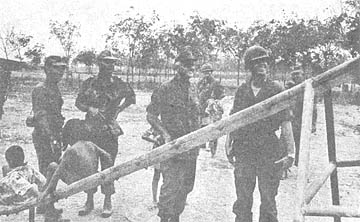 |
WATCHING children from the village of Tan Thoi frolic on a new piece of playground equipment is MG John C.F. Tillson III (2nd from right), 25th Inf. Div. CG. The equipment was built for the children by men of the 3rd Sqdn, 4th Cav. Also watching the fun are (from left) CPT Dennis L. Fontaine and LTC George S. Webb, both of 3/4 Cav., and CPT John P. Otjen (right), the general's aide. |
Combat Wise in Big Hurry
DAU TIENG - A new man to the Ivy Div'.s 3rd
Bde., learned that it
doesn't take long before you're in combat.
Three days after PFC Clyde A. Renand of Slidell, La., joined the
first platoon of Co. C, 3rd Bn., 22nd Inf., he was out on operations. It
was a bad night even for a veteran: it was exceptionally dark and the rain was
falling in torrents.
"I wasn't expecting anything to happen, because it was early,
then all of a sudden the trip-flare went off." Renand continued, "I
fumbled with the safety on the Claymore mine and it finally went off killing
three of the Viet Cong just 10 meters to our immediate front.
"If it hadn't been for that trip flare the VC would have walked
in on us because it was dark and raining hard," Renand said.
The next morning, Co. C made a sweep of its perimeter which
produced three dead and one live, but very scared, Viet Cong. The
searchers also found four rifles, grenades and a complete medical kit, wrapped
in a Claymore mine carrying bag.
Basic Skills Re-taught
DUC PHO - Always trying to improve their "batting average" the
1st Bn., 35th Inf. has started a small unit combat leader course.
"We plan on having one class every month in an effort to
re-emphasize the basic skills of the infantry and to train future fire team
leaders," said MAJ James E. Moore Jr., the "Cacti Green" commander. "The enthusiasm demonstrated by the students indicates to me that they
appreciate the course and think it's valuable."
Students selected for these classes have been in combat situations
and are judged to be squad leader material.
SP4 Jerry L. Young from Baltimore, part-time point man for Co. B,
thinks "These classes are helpful; they refresh my memory on procedures that
can win battles and save lives."
Another student, Eugene T. Harris Jr., from Glenolden, Pa., a
rifleman in Co. A, said, "I have learned some practical things I was never
taught in A.I.T. and I'm going to pass on all this information to the other
members of my unit."
Most of the classes are a review of skills the soldiers had learned
in either basic training or Advanced Individual Training. Courses include:
map reading, ambushes, immediate reaction drills, identification of booby traps,
combat assaults and extraction procedures. In addition, other classes,
such as forward observing procedures (F.O.), introduce new skills which were not
covered in stateside training.
Departs II Corps
1st Air Cav Div Salutes 3rd Bde Task Force
DUC PHO - On the departure of the 3rd
Bde. Task Force, 25th Inf. Div.
from II Corps and the operational control of the 1st Air Cav., the 1st Cav. sent
the following:
". . . We of the First Team would like to pass on to you and your
command our congratulations on a job well done . . . The 3rd Brigade Task
Force has shown itself to be fearless, aggressive and inspired with the will to
win. Its success in the Crescent, Nui Mieu, Soui Ca and Crazy Horse
(during Operation "Pershing") add impressive pages to the distinguished
history of this outstanding unit.
"The loss of the 3rd . . . will be felt throughout the division.
Having worked side by side with our brigades, we have come to consider the 3rd
Brigade Task Force as a member of the First Team.
"Through the inspiring leadership of its officers and
noncommissioned officers, and the resolute determination of its courageous
soldiers, the 3rd Bde., 25th Div., has received laurels not normally awarded to
units of this size and has clearly merited the retention of its motto, 'None
Better.'
"We of the 1st Air Cav Div., salute the men of the 3rd Brigade
Task Force, 25th Inf. Div. and wish them well in the future."
'On The 7th They Rested'
DAU TIENG - Each enlisted man of the 2d
Bn., 12th Inf has a brand
new club of his own. Requiring some $1000 and only about seven days of
hard labor, neighboring Vietnamese villagers constructed the hootch strictly
from bamboo shoots and completed it with a waterproof thatched roof.
Situated immediately adjacent to the NCO club built some two weeks
previous from the same plan, the EM club provides the footsore soldier a place
of rest and relaxation when he returns from the field.
| IT GETS THICK in the Boi Loi Woods as PFC Tony Kaczmarek can attest. A member of the 1st Bn. (Mech), 5th Inf., participating in Operation "Manhattan," he takes a moment to stop, look and listen. (Photo by 1 LT A.R. Karel) | 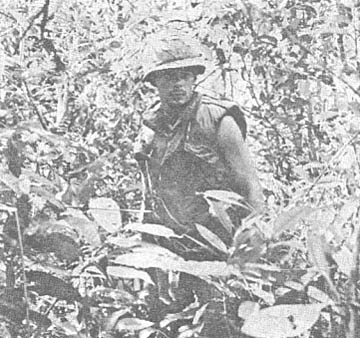 |
Page 4-5 TROPIC LIGHTNING NEWS May 15, 1967
Up Up And Away
"This instrument is a radiosonde. It
is not dangerous and is of no further use to the government. Do not
return." This is the obituary of a delicate piece of equipment that is
most essential to the mission of the 25th Inf. Div. Arty . . . that of putting
artillery rounds in the place where they will do the most good.
In order to get a round on a target the Fire Direction Center (FDC)
must consider many factors other than elevation, deflection, powder charge and
range. The FDC must know the ballistic air conditions that will affect the
projectile on its way to the target. Getting this information is the job
of the Division Artillery Meteorology (Metro) Section.
As CWO Jame T. Kamago of Salt Lake City, Utah, the DivArty Metro
Officer, remarked, "We don't predict the weather, we just measure the actual
conditions as they pertain to artillery. However, the Air Weather Service
uses the information we obtain on the upper atmospheric conditions."
The radiosonde, carried aloft by a hydrogen-filled balloon, is the
measuring instrument used to record, and transmit back to the plotting van, the
current atmospheric pressure, temperature and humidity. These readings are
then converted to ballistic temperature and density. In addition, the
flight of the balloon is tracked by a Rawin Set, giving the wind speed and
direction. For artillery purposes these readings are taken up to an
altitude of 18,000 meters.
After all the information has been recorded, interpreted and
converted for artillery usage it is forwarded to the FDC where they compute the
effect the current atmospheric conditions will have on the flight of the various
sizes of artillery rounds and assure a metro correction to all firing batteries.
The importance of these metro corrections is emphasized when it is noted that
certain air conditions can cause a deviation of up to 25 per cent of the range.
The average flight of each balloon is one and one-half hours and
the section releases four balloons daily. In addition to the "Tropic
Lightning" artillery, other units within a 32 km radius of Cu Chi utilize this
metro data.
|
Photos by SP4 Ron Shirk |
| PREPARE FOR TAKEOFF - PFC William J. Morgan of Los Angeles, Calif., and PFC Craig Cahill, right, of Oakland, Calif., attach the radiosonde to the balloon as launch time nears. The launching reel, laying on the floor, is used on windy days to attach the radiosonde to the balloon instead of the usual 20 meter length of cord. | 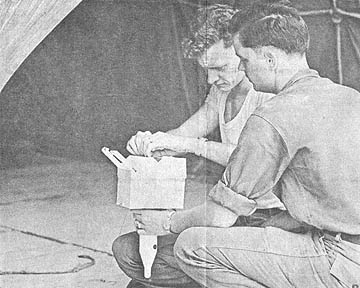 |
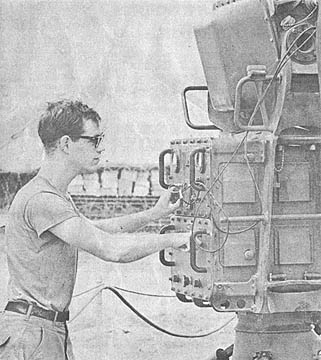 |
FOLLOW FELLOW - When the balloon is launched, PFC Henry J. Wynsen of Columbus, Ohio, checks the tracking Rawin Set to insure it is locked on the frequency of the radiosonde. As the set follows the flight of the balloon, it records the wind direction and velocity. |
| PSSST - PFC Cahill, left, and SP6 David B. Arriola from Guam, NCOIC of the Metro section, attach the balloon to the filler pipe. "Free Lift" is reached when the balloon has been filled with sufficient hydrogen to lift the 3200 grams of weights attached to the bottom of the filler. | 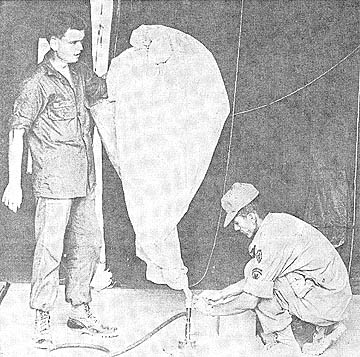 |
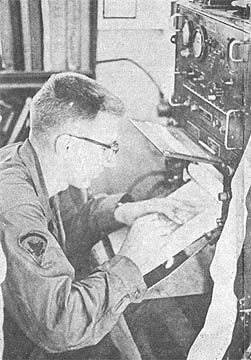 |
CHARTING, CALCULATING AND CHECKING - SP5 Gary W. Krahl of Milan, Ill., operates the radiosonde recorder and is recording temperature, humidity and air pressure on the graph paper as it comes out of the recorder. |
| END OF COUNTDOWN - The balloon is off as PFC Cahill releases it. For the next hour and a half, the average flight time of each balloon, will be a busy one for personnel of Metro as they plot the information received on the present air conditions. | 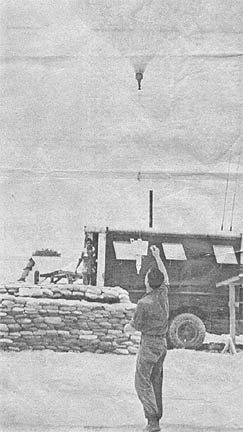 |
Page 6 TROPIC LIGHTNING NEWS May 15, 1967
Travel Bureau-25 Keeps Quite Busy
Although they've occasionally been accused of being a
fly-by-night outfit, the Teenie Weenie Air Transport Service has already logged
more than a year's service from Cu Chi Army Airfield to various scenic points
in III Corps.
Teenie Weenie Air - or TWA as 25th Div. wags call it - has its
chairman of the board and president, but vice-presidents in charge of scheduling
and scrounging (who do most of the work) are two division headquarters majors -
George Newton and Charles Houser. Their official title is assistant
division aviation officers.
Their job summary alone fills a page of single-spaced typewritten
paper and includes 18 different responsibilities. They range from advising
the commander on aviation matters, to scheduling courier flights, to controlling
and scrambling fire teams of helicopter gunships in event of an attack on the
base camp.
MAJ Houser, a rugged, 30-year old career officer from Lincolnton,
N.C., allows that all 18 missions are difficult at times, but says that
allocating passenger spaces on the 30 courier flight sorties daily gives him
most of his headaches. In a way, it's a wonder he even has time for
headaches - the two majors have direct control over some 900 sorties a day.
MAJ Newton felt getting enough ships was a big problem. "The real difficulty is that very seldom can we get enough ships for every
mission. Therefore we have to set the priorities here - and they go
primarily to combat missions." Sometimes he has to say no, but not often.
TWA, with a staff of three officers and three enlisted men, serves
an incredible area of 4200 square kilometers in Tan An, Long An, Tay Ninh, Binh
Duong and Hau Nghia Provinces. Unfortunately, another of those 18
responsibilities is to monitor the use of all 900 sorties daily. "From
three in the afternoon to eight in the evening, nobody even has time to sit
down," said Houser, "the reason being that everybody's either finishing up
their missions in a hurry or requesting new ones they forgot to ask for in the
morning."
Newton's face crinkled into a smile as he said, "But not
everything is troublesome or depressing around here. Sure, we have
problems like everybody else, but once in a while something comes up to provide
a little comic relief. A few weeks ago we had a man at Long Binh who was
waiting for a flight back to Cu Chi.
"We had to send some inexperienced aviators after him and they
didn't know the area very well. They went there and back three times
without finding him, always landing about 50 meters from him, but on the other
side of a minefield. He couldn't get their attention and he couldn't
cross the minefield, so they flew back without him."
Newton paused and laughed again and said, "You know? I
think he's still there!"
In a more serious vein, the major continued, "Our job is support.
If someone makes a mistake and the men in the field don't get re-supplied, we
don't take time out to criticize, we just get in there and get the job
done."
Satisfaction of accomplishment is as much a part of the (text is
missing here - xerox copy wrinkle). You get a real good feeling inside
when the gunships you've scrambled get a few VC. That's when you feel
you've accomplished something," said Houser.
In the eyes of the men in the field, Teenie Weenie Air isn't so
teenie weenie after all.
Ivy 'Beau' Tough Cat
DAU TIENG - Beau is a 70-pound German Shepherd working with the
44th Scout Dog Platoon at Dau Tieng. He's friendly and wags his tail,
but he's also an aggressive animal and has tasted the bitterness of war.
With only five months of combat behind him Beau has been wounded on two
different occasions - he almost died once.
"It was on a three day operation," Sp4 Michael R. Phillips,
Beau's handler, said as he described the first time the dog was wounded while
working with the 3rd Bde., 4th Inf. Div. "We were moving out of a large
clearing and had just reached a woodline when Beau alerted." Immediately
Phillips dove for cover and the Viet Cong activated a well-planned ambush.
"An AK-47 round struck Beau in the front leg," the 20-year old handler said.
The wound wasn't serious and the dog, valued at $2500, was
quickly back in action again when Operation "Junction City" was launched in
the rugged War Zone C area.
Phillips and Beau were sitting in a clearing preparing to move out
when artillery rounds began piercing the air.
"Beau gave a strong alert - his head was straight up,"
Phillips said. "That only meant one thing - the shells were coming at
us!"
Ten rounds later Beau and Phillips both lay wounded. A piece
of shrapnel had passed completely through the dog's middle breaking part of
his backbone, and then struck Phillips in the right arm.
Evacuated to Saigon the dog's death certificate was filled out
due to the seriousness of the wound, but Beau "didn't give up" and 39 days later
the certificate was torn up. The dog is now back at the Ivymen's base
camp.
"I wouldn't trade him for any weapon," Phillips said. "He's my best protection. He can tell you where Charlie is."
Operation Over
Lightning Wraps Up 'Pershing'
DUC PHO - After 66 days of ceaseless patrolling in sand, rice
paddies, jungle and up 60-degree-inclined slopes in 106-degree heat, the 3rd Bde. Task Force, 25th Inf. Div. wrapped up Operation "Pershing" at noon on
April 19.
"Pershing" was not the brigade's longest operation, nor did
it include the heaviest fighting the brigade has been in. "Pershing"
did however, see the 3rd Bde. clear the NVA and VC from northern Binh Dinh
Province, an area the enemy had been able to call home for a decade, in eight
weeks time.
"Tropic Lightning" represented by two battalions, had the
biggest area of operation for the longest time of any similar sized unit on
"Pershing".
The "Cacti Green" concentrated on the Nui Mieu and Crescent
areas, but, according to their liaison officer to brigade, 1LT Lawrence Connor,
they managed to also patrol in and around Nui Gop Trat Mountain and the 506
Valley. On March 6 and 7 they engaged elements of an NVA battalion at Hoa
Tan in the northern Crescent area, killing 81 in what was the brigade's
largest battle during "Pershing".
The 1st Bn., 14th Inf. continued to patrol and control the lower
Soui Ca as they had during "Thayer II." The "Golden Dragons"
emphasized ambush and deception tactics. CPT Scott's "Can B Done"
Company heli-assaulted into LZ "Corral" in February where they engaged an
NVA company which could not be persuaded to stay and fight. It is believed
to have been the battalion's biggest engagement of "Pershing".
Co. D, 65th Engrs. accomplished a "first" in "Pershing" in
opening Highway 506, a dirt road that cuts through the hostile 506 Valley.
They were consistently harassed by enemy sniper fire, mines and once by an NVA
platoon. Their attempt marked the third engineer try to open the road.
On "Pershing" the brigade mixed civic action and military
tactics more deliberately and conscientiously than ever before.
Coordination was made with ARVN units and district on a daily basis.
Before a U.S. unit moved out of an area, co-ordination was made with the ARVNs, so control of the area would not slip and so
projects could maintain their momentum.
Cu Chi Colleen Calls On Combat Cousin in Chopper
DAU TIENG - A pert Irish colleen from County Mayo, Ireland, paid a
visit to her cousin here at the 3rd Bde., 4th Div. base camp recently - a cousin
she had never met.
Miss Claire Hoban, an auburn-haired, green-eyed 23 year old miss,
works in the PX of the 25th Div. at Cu Chi selling cars. She heard that
there was another Hoban, also from County Mayo here with the "Ivymen."
On her day off, she hopped a chopper to Dan Tieng and after a few
inquiries was talking to her cousin, PFC Brendan T. Hoban, a rifleman with Co.
C, 3rd Bn., 22nd Inf.
"We had never met before and I didn't even know whether we were
cousins or not until we straightened out some aunts and uncles," commented
Miss Hoban.
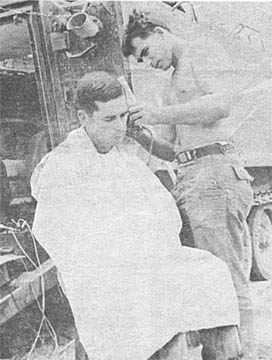 |
BARBER SHOP (MECH) - PFC Albert Warfield of Co. B, 1st Bn., (Mech), 5th Inf. opens the "Bobcat Barber Shoppe". "Fair Hair Care in a Strac Track." |
Page 7 TROPIC LIGHTNING NEWS May 15, 1967
Tense Start For MEDCAP
By 1LT A. R. Karel
Rung Cay is a tiny hamlet just outside the Operation
"Manhattan" base camp of the 25th Inf. Div.'s 2nd Bde. The road
running through Rung Cay had been mined by the Viet Cong frequently during the
first days of the operation, slowing traffic on that main supply route.
Somehow the people of Rung Cay had to realize that the Allied
effort being made to their north was to help them, and that they could help by
pointing out Viet Cong mines.
The answer was a Medical Civil Affairs Program (MEDCAP) combined
with food and clothing distribution. The program would include
distribution of leaflets explaining the Allied effort and offering a reward to
villagers who pointed out VC mines.
The biggest problem was that no one had ever held a MEDCAP in the
hamlet before. Civil Affairs officers didn't know what kind of reception
would greet them.
The morning of the MEDCAP, another mine had been found just north
of the hamlet, and there were reports of a Viet Cong unit operating in the area.
The 90-man security force that had been planned for to protect the
program was assigned another mission at the last moment. MAJ Gordon
Corcoran, brigade Civil Affairs Officer, decided to go without them.
The tiny convoy of five vehicles rolled out the base camp just
before noon and jostled its way down the muddy road to Rung Cay. The four
men in the lead vehicle all kept a constant watch to the front for the telltale
bumps of freshly packed earth that meant mines.
"All I could think of as we entered the hamlet was the rule that
if you saw a lot of kids running around, the VC probably were not in the
area," said CPT Donald Harmon, Civil Affairs officer of the 1st Bn., 27th Inf.
There was no one. Houses looked deserted and rakes were left leaning
against trees in the fields.
As the group approached the center of town, a high-powered public
address system in the lead vehicle was switched on and an interpreter began to
tell all villagers who could hear why the vehicles were coming into their
hamlet.
By the time the group reached the hamlet square, a few children
were cautiously walking toward them. More and more people began to appear
as the district chief used the loudspeaker to explain what the Allies were doing
in the area and why they were in the hamlet.
Medics set up examining stations for the doctors from the 1st Bn.,
8th Arty., and the 1st Bn., 27th Inf. By the time the stations were
complete, long lines stretched away from them.
As the doctors worked, arrangements were made with the village
chief for distribution of food and clothing. Leaflets were handed out
explaining the Allied effort and asking that the people help by pointing out
mines in the hamlet's roads. Everyone smiled and laughed as even more
people came.
Before the day was over, the doctors had treated more than 180
patients. Civil Affairs workers distributed through the village chief, 72
gallons of cooking oil, 500 pounds of rice, 250 tubes of toothpaste, 2,500 bars
of soap, and more than 1,000 pounds of clothing.
"We felt a lot better leaving the village than entering," said
MAJ Corcoran, "the people waved us off like old friends when we left."
Did the MEDCAP do the job intended? It probably will never be
proven one way or the other. But there were no mines found in the road
through Rung Cay up to the writing of this report five days later.
|
|
|
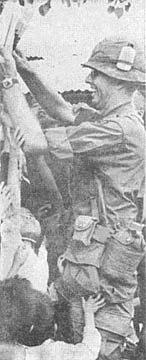 |
| NEW FRIENDS - The people of Rung Cay gather around the entrance of the building used for the MEDCAP after losing some of their apprehension over the strangers. Food, clothing and soap were given to the people. | 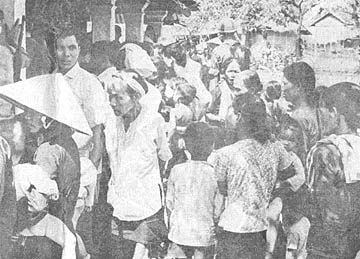 |
Close Call
Luck About to Change - Hopefully
DUC PHO - SGT James A.Hull, five-time recipient of the Purple
Heart, has had his share of ups and downs. He had received four Purple
Hearts for actions in Korea, and three weeks after he arrived in Vietnam he was
in the hospital with malaria.
He returned to his unit, Co. B, 1st Bn., 35th Inf. (the same
Battalion he was with in Korea) only to trip a Viet Cong boobytrap. Wounds
from the shrapnel sent him back to the hospital where he was, presented his fifth Purple Heart.
Resolved to give a little instead of. take so much, SGT Hull went
back to his unit for a third time. A week later, as he sat behind a
clump of brush reading a letter, three laughing North Vietnamese Army regulars,
who were obviously returning from a fishing trip, approached him.
Hull opened up and brought them to the ground with a burst from his
M-16.
His latest incident was with a 150-pound test fishing line found
tied to a bridge.
"This isn't anything but a fishing cord," Hull said as he
brushed against the line.
Nothing happened.
After four minutes of tracing the line, Co. B came to the other end
and a hand grenade attached to a 500 pound bomb.
With a sigh of relief because he hadn't tripped the boobytrap,
Hull said "Maybe my luck is about to change!"
What Sort of Man Reads TLN
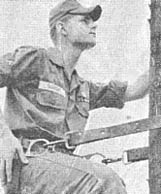 |
Installing and maintaining the entire wire communications system for a combat brigade is a big job. For SGT Matin R. Solman of the 25th Inf. Div.'s 2nd Bde. it's also a very interesting job. SGT Solman, of New York City, is the wire foreman for both the brigade rear and combat forward base. First into a new area and last out is the rule for the two wire teams he heads. "Keeping dependable commo going in the field means long hours. It's very challenging work," says SGT Solman. |
Page 8 TROPIC LIGHTNING NEWS May 15, 1967
VC Kill Civilians
Three civilians were killed and six seriously wounded in a two day
period by Viet Cong mines in an area south of the Operation "Manhattan" zone
of operations.
An old man and two young children died when a Viet Cong mine
blasted their oxcart on a heavily traveled civilian road north of the city of
Trang Bang.
Six mining incidents have taken place on the stretch of road that
links Trang Bang to a small hamlet and the forward base camp of the 2nd Bde. of
the 25th Inf. Div., in the two weeks since the beginning of the massive
operation.
"This is the second time in as many days that the Viet Cong have
killed or wounded innocent civilians with explosive devices," said Maj. Lynn
Steverson, a 2nd Bde. staff officer.
The day before the mining incident, six civilians were seriously
wounded when the VC employed a command detonated mine against them.
The road has been used for military convoys supplying the base camp
but is heavily traveled by civilians.
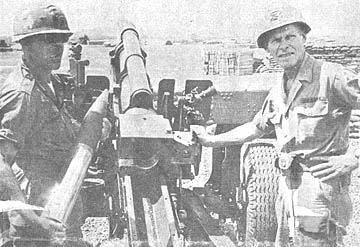 |
LOCK AND LOAD 100,000 - As one of his last acts before leaving the 3rd Bde., 4th Inf. Div., COL Marshall B. Garth (right) fired the 100,000th round of artillery for the 2nd Bn., 77th Arty since their arrival in Vietnam. LTC Fred J. Merritt, the artillery battalion commander holds the highly polished shell casing. (Photo By LT Ralph Campbell) |
COL Garth Heads for Pentagon,
Leaves Ivymen After 16 Months
DAU TIENG - The man responsible for gathering almost 3000 draftees
together at Fort Lewis, Wash., training them as a fighting unit, and then
bringing these men to Vietnam where they have fought in six major operations,
has left the 3rd Bde., 4th Inf. Div. COL Marshall B. Garth has been
reassigned to the office of the Joint Chiefs of Staff at the Pentagon after
commanding the Ivymen for the last 16 months.
COL Kenneth E. Duell has taken over command
"You men are the smartest and most capable men that I have had
the privilege to serve with in 26 years of service," Garth told the brigade as
he made his farewell speech. "You are the greatest soldiers our Army has
ever produced."
"If I did what I feel like doing," the colonel said in an
aggressive voice, "I would dig my heels in and they would have to drag me
away."
The colonel, taking numerous risks right along with his men,
supplied the needed punch to defeat the 272nd Viet Cong Main Force Regiment when the
enemy unit decided to attack a brigade artillery support base while on Operation
"Junction City." He was awarded the Silver Star for his actions.
| MG Frederick C. Weyand, former 25th Inf. Div. CG, has been
named to succeed LG Bruce Palmer as commander of II Field Force in Vietnam. GEN Palmer will become a deputy to GEN William C. Westmoreland, the U.S. commander in Vietnam. GEN Weyand will be promoted to the three star rank with the change. |
BSM to All
BONG SON - Bronze Stars were presented to all members of one
hard-fighting, LZ-cutting squad of engineers by their company commander, CPT
Arthur. J. Pansze at the 3rd Bde. Task Force, 25th Inf. Div. forward command
post.
The men of Co. D, 65th Engr. are: SSG Richard D. Foreman of Des
Moines, Iowa; SGT Gary L. Dulaney of Rock Island, Ill.; SP4 Earl S. Baker of
Jacksonville, Fla.; and SP4 Jackie L. Green of Bostic, N.C.
The four men were with the 1st Bn., 14th Inf. in Nov. when the
"Dragons" engaged two North Vietnamese Army battalions west of Plei Djereng.
The engineers immediately began cutting a landing zone for resupply
and medical evacuation. They operated chain saws, planted and exploded
demolitions, resupplied the infantry with ammunition, retrieved U.S. dead and
wounded and got them on the helicopters, and administered first aid - all the
time under steady enemy fire.
It marked one of the few times a whole squad was decorated for the
same action and the first time a Co. D, 65th Engr. unit has been so decorated in
Vietnam.
The 65th Engr., nicknamed the "Whiskey Fifth" for reasons best
known only by themselves, are still the "First In, Last Out."
Relief Quietly Takes Over
DAU TIENG - On the morning of April 30, 1967, in the course of his
duty on the bunker line of the 3rd Bde., 4th Div.'s Camp Ranier at Dan Tieng,
Sp4 James R. Brown, Hq. Co., 2nd Bn., 12th Inf., was suddenly and unexpectedly
relieved from his post.
The relief, a four foot long cobra, quietly slithered into the
bunker about 10 in the morning after first pausing, briefly to inform Brown he
was taking over. Brown, understandably not appreciating the relief, made
an unsuccessful last ditch effort to persuade the snake otherwise by dropping a
box of claymore mines from the top of his bunker onto the snake.
Shortly thereafter, reacting to a call for help from Brown, SGM
Mullins and MSG Therriault from battalion headquarters appeared on the scene
complete with smoke grenades, tear gas, and their .45 caliber pistol.
After one tear gas and two smoke grenades were tossed into the bunker and still
no sign of movement, sand bags were removed from the top of the bunker in an
attempt to catch a glimpse of the intruder. Therriault then approached the
bunker with a club in one hand and a .45 in the other, but the tear gas kept him
from getting too far.
Some four hours after the original encounter, the tear gas was
still so strong that it was impossible to enter. Brown operated from a water can
some twenty meters to the rear of the bunker until the gas cleared. A
detailed search made with utmost caution revealed no trace of the beleaguered
snake.
196th Yearbook Now Available
The 196th Lt. Inf. Bde. is now taking orders for its 112-page
yearbook, "The Second Year."
The pictorial review of the brigade's activity in Vietnam costs
$5. A postal money order may be made payable to: Information
Officer, Hq., 196th Light Infantry Brigade (Sep), APO SF 96256. All orders must
reach the Information Officer no later than June 5.
Personnel should include their present address and their permanent
home address along with their orders.
Anyone may buy a copy of "The Second Year."
Rice Cache Smashed
DAU TIENG - While cutting lanes of fire, PSG Richard L. Bartels of
Tampa, Fla., stumbled onto a well concealed cache of rice.
"I've been in Vietnam over six months," said Bartels, a
member of Co. B, 2nd Bn., 22nd Inf., "and this is the most elaborate cache
I've ever seen. There was aluminum siding for a roof, sides, and bottom
of the hole. The floor and sides were raised about one foot from the
surrounding ground. Even the wood frame was joined by mortise and tendon wood joints."
The 8 by 8 by 20 foot cache held 250 one hundred pound bags of
polished rice. They were evacuated for use in the brigade civil affairs
program.
It is felt that the area of operation near the Boi Loi Woods in War
Zone C houses the Viet Cong apparatus for control of terrorist activities in the
Saigon area.
'BCs' Arrive, Pantless VC Exits Switfly
"That's a roger, sir. We caught Charlie with his pants down."
That was the report sent in by SGT William L. Kelley, a squad leader from the
1st Pit., Co. C, 1st Bn. (Mech), 5th Inf. Bobcats."
A platoon size base camp had been found with laundry drying on the
line and at least one VC was observed leaving the scene with no pants on.
Three large bunkers, 30 foxholes, 800 pounds of rice and warm food
still on the table were found along with a picture of Mao Tse-Tung.
| NICE RICE HAUL - Men of Co. B, 2nd Bn. (Mech), 22nd Inf., load 250 one hundred pound sacks of captured VC rice. The cache was uncovered during. Operation "Manhattan." (Photo By PFC James Friar) | 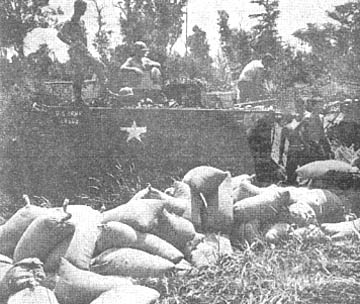 |
Thanks to
Ron Krahl, 25th Aviation Bn. for sharing this issue,
Ron Leonard, 25th Aviation Bn. for locating and mailing it,
Gary Hartt, 2nd Bn., 22nd Inf., for providing an issue to scan for photos,
Kirk Ramsey, 2nd Bn., 14th Inf. for creating this page.
This page last modified 8-12-2004
©2004 25th Infantry Division Association. All rights reserved.